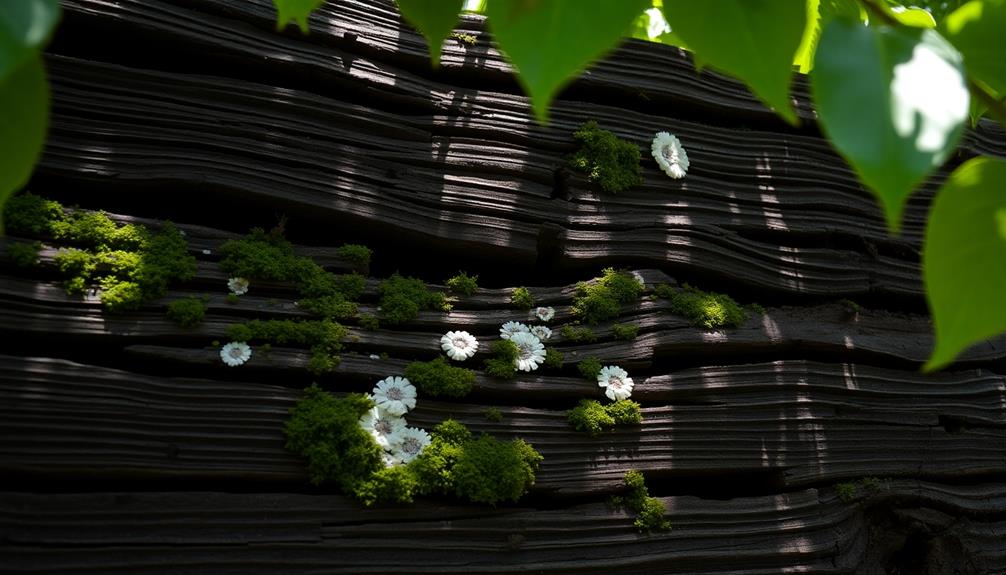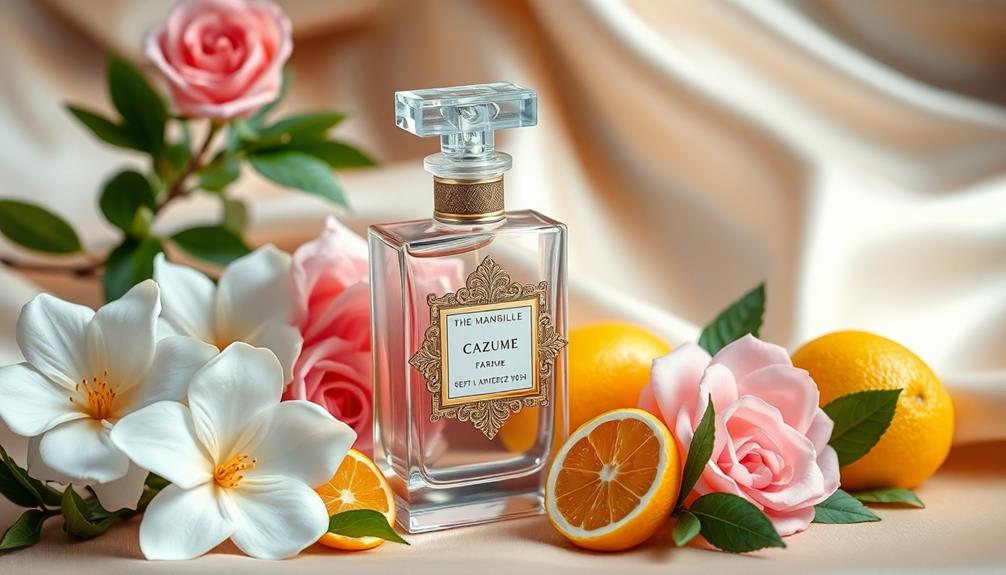Sandalwood smells like a warm hug from nature, mixing creamy, sweet, and spicy notes that make you feel cozy and relaxed. When you take a whiff, you might notice its soft, buttery scent, with earthy undertones adding a touch of brightness. It's like being surrounded by a peaceful forest! There are two types: Indian sandalwood, which has a deep, rich sweetness, and Australian sandalwood, a fresher and greener option. This lovely aroma is great for yoga and meditation, helping you unwind. If you're curious about how it enhances your everyday experiences, there's plenty more to discover!
Key Takeaways
- Sandalwood has a creamy, warm aroma with sweet, spicy, and musky notes, evoking a sense of nature.
- Indian sandalwood offers a deep, soothing sweetness, while Australian sandalwood has a fresher, greener scent.
- The fragrance transitions from sweet and spicy to a soft, buttery aroma with earthy undertones.
- Key components like alpha-santalol and beta-santalol contribute to its long-lasting fragrance and complexity.
- Sandalwood is often associated with serenity and emotional balance, enhancing relaxation and mindfulness.
Introduction

Sandalwood consistently captivates with its creamy, warm aroma that blends sweet, spicy, and musky notes. This delightful sandalwood scent belongs to the woody fragrance family, which means it can remind you of nature and the great outdoors. When you take a whiff, you might notice how buttery and exotic it feels, setting it apart from other woody fragrances like cedar and pine. Its richness creates a grounding effect, making it a popular choice in perfumery and aromatherapy for promoting relaxation and tranquility. Unlike the crisp and citrusy characteristics of *what lemongrass fragrance resembles,* sandalwood offers a deeper, more enveloping experience. Together, their contrasting profiles can complement each other beautifully in blended scents.
Indian sandalwood, known scientifically as Santalum album, brings a deep, rich sweetness, while Australian sandalwood, or Santalum spicatum, offers a fresher, greener scent. The aroma of sandalwood is so unique because of its special components, like alpha-santalol and beta-santalol. These give it a long-lasting, creamy scent that many people adore.
Not only does sandalwood smell amazing, but it also has health benefits! People use essential oils from sandalwood in aromatherapy because they find it calming and soothing.
Whether in perfumes, incense, or therapeutic applications, sandalwood's enchanting aroma helps create an inviting atmosphere. So, are you ready to explore the wonderful world of sandalwood? You'll be amazed by how it can brighten your day!
Description of the Smell

The enchanting aroma of sandalwood offers a unique olfactory experience that captivates the senses. When you take a whiff of sandalwood, you'll notice its creamy and smooth fragrance. This scent is warm and inviting, making it perfect for creating a cozy atmosphere. The initial notes of sandalwood give off sweet and spicy hints, which gently settle into a soft, buttery aroma. It's like a warm hug for your nose!
Unlike other woody scents, such as cedar and pine, sandalwood has earthy undertones that add brightness and sweetness to its fragrance. You might feel a sense of calmness and tranquility wash over you as you breathe in its soothing aroma.
There are different types of sandalwood, too! Indian sandalwood has a deep, creamy sweetness, while Australian sandalwood offers a fresher, greener scent.
The essential oil of sandalwood is special because it acts as a fixative, helping the fragrance last longer in perfumes. This means you can enjoy the delightful notes of sandalwood throughout your day, bringing a little piece of nature with you wherever you go!
Source and Composition

Derived from the heartwood of specific sandalwood tree species, the captivating scent you adore comes primarily from essential oils extracted from Indian sandalwood (Santalum album) and Australian sandalwood (Santalum spicatum). These trees are special because their heartwood contains the most wonderful aromas.
When you think of sandalwood oil, picture a creamy, woody aroma that feels warm and inviting. The key players in this delightful scent are alpha-santalol and beta-santalol. These compounds give sandalwood its unique fragrance, making it slightly sweet and oh-so-pleasant.
Indian sandalwood is known for its deep, warm, and creamy sweetness, while Australian sandalwood offers a fresher, lighter aroma with earthy hints. Isn't that cool? The way sandalwood oil is extracted, mostly from the heartwood, can change how strong or complex the scent is.
This heartwood is like a treasure chest of rich aromas, making sandalwood oil a fantastic addition to perfumes. It acts as a fixative, allowing the scent to linger and adding depth to your favorite fragrances.
Typical Scenarios or Environments

Many people seek out the calming presence of sandalwood in various settings. When you walk into a yoga studio or a spa, you might notice that sandalwood smells warm and inviting. This soothing scent creates calming environments perfect for relaxation and mindfulness, making it a popular choice for spiritual retreats that focus on meditation and inner peace.
You'll often find this unique olfactory experience in aromatherapy practices, where diffusing sandalwood helps you unwind after a long day.
Sandalwood also plays a special role in Indian ceremonies. During these events, it's used in incense, adding to the spiritual experiences that many cherish. The rich fragrance of sandalwood can make you feel connected to culture and tradition.
In addition, sandalwood smells wonderful in luxury perfumes, making social gatherings and formal events feel more elegant. Just think of the woody scents like cedar that mingle with sandalwood, creating a delightful atmosphere.
Even in the kitchen, some Southeast Asian dishes use sandalwood to enhance flavors, bringing a touch of tradition to your meals.
Emotional or Cultural Associations

Sandalwood embodies a sense of serenity and cultural richness that resonates deeply with many people. This special wood has a calming aroma that's often used in meditation. When you breathe in sandalwood, it can help you feel a sense of inner peace and emotional balance.
Many cultures have cherished sandalwood throughout history, using it in traditional medicine to promote mental well-being. Sandalwood is considered a sacred scent in various cultures. In ancient Egypt, it played a vital role in rituals and even embalming practices.
This connection to cultural heritage makes it even more special. When you smell sandalwood, it might bring feelings of nostalgia, reminding you of comforting moments from your past.
You might find that sandalwood helps you connect with your emotions, making it easier to relax and focus. It's no wonder that people around the world adore this wonderful scent!
Health or Safety Considerations

When using sandalwood, it's important to be mindful of safety considerations. Sandalwood essential oil can be wonderful for your senses, but you need to use it carefully. If you have sensitive skin, it might cause skin irritation or allergic reactions, so always do a patch test first. If you're allergic to other plants in the Santalaceae family, be extra cautious with sandalwood products.
Also, if you're pregnant or breastfeeding, it's best to consult healthcare professionals before using sandalwood. There isn't enough information on how it might affect you or your baby.
And remember, sandalwood can interact with medications, especially those metabolized by the liver, so checking with a healthcare provider is a smart move if you're taking prescribed treatments.
While sandalwood can be lovely for topical use when properly diluted, don't ingest it or its oil without professional guidance. Doing so might lead to tummy troubles or worse if taken in high doses.
Final Thoughts

Experiencing the enchanting aroma of sandalwood can be a transformative journey, inviting calm and tranquility into your life. When you take a whiff of sandalwood smell, you'll notice its creamy, warm, and woody notes that wrap around you like a cozy blanket.
This delightful scent features sweet, spicy, and musky elements, making it brighter and sweeter than other woody scents like cedar.
You might find that Indian sandalwood, with its deep, creamy sweetness, feels especially soothing. On the other hand, Australian sandalwood offers a fresher, greener aroma.
Sandalwood is often used as a base note in perfumes because it lasts a long time and adds depth to fragrance compositions. The essential oils of sandalwood contain aromatic compounds, like santalol, which are highly valued for their calming effects.
Whether you're using it in aromatherapy or simply enjoying the scent in your favorite perfume, sandalwood can turn an ordinary moment into something special.
Frequently Asked Questions
What Scent Is Similar to Sandalwood?
If you're looking for scents similar to sandalwood, try vetiver for its earthy aroma, cedarwood for warmth, or patchouli for richness. Amyris also offers a sweet, woody note that resembles sandalwood's profile nicely.
Is Sandalwood Smell Attractive?
You'll find sandalwood's scent incredibly attractive. Its creamy, warm aroma creates a soothing atmosphere that many find comforting. This unique blend of woody and musky notes appeals to a wide range of personal preferences.
Is Sandalwood a Feminine Scent?
You might find sandalwood isn't strictly feminine. Its rich, creamy aroma appeals to all genders, enhancing various fragrances. Personal preferences shape your perception, making it versatile and attractive regardless of traditional scent classifications.
Does Sandalwood Smell Like Patchouli?
Sandalwood doesn't smell like patchouli. While sandalwood offers a creamy, smooth aroma, patchouli presents a heavier, earthy scent. Their distinct profiles can complement each other, but they evoke different feelings and experiences altogether.









